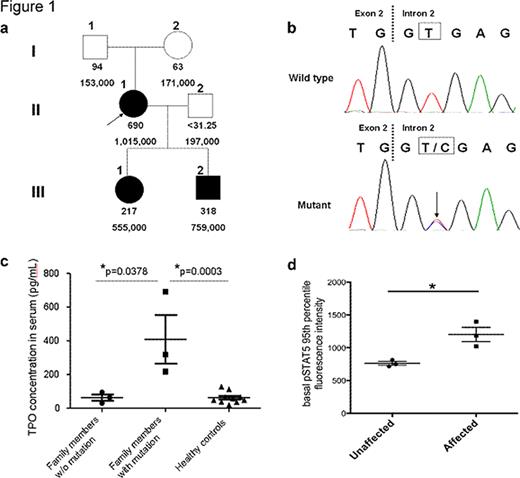Abstract
Abstract 3086
Hereditary thrombocythemia (HT) is a rare autosomal dominant disorder related to mutations in either the gene encoding thrombopoietin (THPO), or its receptor MPL. In some cases of HT, mutational involvement of the THPO or MPL genes has been excluded. To date, five HT families with three distinct THPO mutations have been published, including Dutch, Japanese, and Polish pedigrees. In all cases, the mechanism of overproduction of platelets is related to alteration of the 5′ untranslated region (5′ UTR) of the THPO gene which results in enhanced translation of thrombopoietin (TPO) mRNA. We present our analysis of a Philippine family with a novel THPO gene mutation which segregates with the thrombocytosis phenotype.
Informed consent was obtained from research participants. Peripheral blood was obtained from 6 family members, and serum was collected from 10 healthy adults. DNA was extracted with the Puregene DNA Isolation Kit (Qiagen). For the human TPO ELISA assay, the serum TPO concentrations of the family members as well as the healthy controls were measured with the human TPO Quantikine kit (R&D Systems). The exon 2 to intron 3 region of THPO gene covering the 3 previously reported mutations was amplified and purified PCR products were sequenced. To examine the functional effects of increased TPO levels on downstream JAK-STAT signaling, freshly obtained PB samples were incubated for 15 minutes at 37C, followed by fixation with paraformaldehyde and lysis of red blood cells. Fixed cells were permeabilized with methanol and stained with a combination of surface marker and intracellular phospho-specific antibodies, followed by analysis on a LSRII flow cytometer. Data analysis was performed with FlowJo (Tree Star).
The proband (see Figure 1a, pedigree subject II-1, arrow) is a 39 year-old Philippine woman who was informed at age 19 that she had an elevated platelet count. Although placed on hydroxyurea, anagrelide, and interferon-α in the distant past, she was currently maintained on only low-dose aspirin. At the time of her presentation at Stanford Cancer Center in March 2010, her complete blood count revealed a platelet count of 1,015,000/mm3 without other abnormalities. The peripheral blood smear revealed occasional large, hypogranular platelets. Reactive causes of thrombocytosis were excluded and her examination was normal. JAK2 V617F mutation analysis was negative. Routine CBC evaluation of her two children revealed thrombocytosis in her 11 year-old daughter (subject III-1; platelet count 550,000/mm3) and 9-year old son (subject III-2; platelet count 759,000/mm3). None of the three family members with thrombocytosis experienced a history arterial or venous thrombosis nor vasomotor symptoms. As shown in Figure 1b, DNA sequencing revealed a novel heterozygous mutation of T>C at the splice donor site of intron 2 in the proband (II-1) and her two children (III-1, III-2), while the proband's parents (I-1, I-2) and husband (II-2)were wild type at this site. In Figure 1a, the pedigree of the six family members with serum TPO concentrations (pg/mL) (1st row) and platelet counts (/mm3)(2nd row) is shown. Figure 1c demonstrates that the serum TPO concentration of family members with the THPO mutation was significantly higher than those family members without the mutation (un-paired t-test, p=0.0378), or healthy controls (p=0.0003). The TPO level in non-affected family members showed no statistical difference with healthy controls (p=0.98). In Figure 1d, basal phosphorylated STAT5 (pSTAT5) levels in CD3−/CD66−/CD14− progenitors were evaluated, and the 95th percentile is presented in the mean with SEM format. An un-paired t-test revealed that pSTAT5 levels were significantly higher in the affected group (p = 0.024, denoted by *).
In our Philippine family, we have identified a novel heterozygous mutation at the conserved T in the invariant donor splice site of intron 2 of the THPO gene. Mutations at this position result in splicing errors, leading to exon skipping, intron retention or exposure of cryptic splice sites. Loss of the inhibitory wild-type 5′UTR has been shown to result in enhanced THPO transcription. This autosomal dominant gain of function germline mutation is associated with thrombocytosis, increased TPO levels, and constitutive activation of JAK-STAT signaling.
No relevant conflicts of interest to declare.
Author notes
Asterisk with author names denotes non-ASH members.


